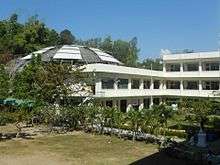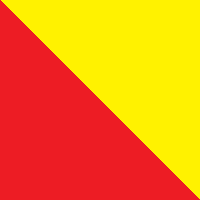Christ the King College (La Union)
| Christ the King College | |
|---|---|
 Serve to Lead, Lead to Serve | |
| Location | |
|
San Fernando City, La Union Philippines | |
| Information | |
| Type | Private, Sectarian |
| Patron saint(s) | Christ the King |
| Established | 1931 |
| Founder | Mother Marie Louise de Meester |
| Grades | K–12 |
| Campus | P. Burgos Campus (Elementary) Sevilla Campus (Secondary) |
| Color(s) | Yellow and Red |
| Affiliation | Roman Catholic, ICM Sisters |
| Nickname | CKC |
| Monicker | CKCians |
| Directress | Sr. Teresita A. Lara, ICM |
| School Heads | Mrs. Florida Areola (Elementary) Mrs. Rosabel Aspiras (Secondary) |
| Website |
www |
Christ the King College is an elementary and secondary school in San Fernando City, La Union. Founded in 1931, it is one of the oldest Catholic institutions in La Union and even in Region 1. Like St. Theresa's College in Quezon City and four others, it is one of the six Immaculati Cordis Mariae (ICM) schools in the country founded by Mother Marie Louise De Meester and ran by Belgian Sisters.
Christ the King College offers elementary and secondary education, with its elementary education situated in the heart of city of San Fernando, and its secondary education situated in Sevilla Campus.
In 2010, CKC celebrates the centennial anniversary of ICM's presence in the Philippines, and in 2011, CKC celebrated its 80th anniversary, under the leadership of Sr. Teresita A. Lara, ICM.
History
On June 10, 1910 when Mo. Marie Louise de Meester, ICM's mother foundress, stepped into the islands of the Philippines. It was then when they started building up schools administered later on by the Belgium - based sisters. In May 1917, two priests, Fr. Donato and Fr. Albano, founded the San Fernando Catholic School within the heart of the town of San Fernando in the province of La Union.[1]
May 12, 1931 marked the arrival in San Fernando of the missionaries of the Canonesses of St. Augustine, now called Missionary Sisters of the Immaculate Heart of Mary (ICM sisters). The two priests, Fr. Donato and Fr. Albano, then turned over the administration of the parish school to the ICM sisters.[2]
In 1946, the school offered the Elementary Teacher’s Certificate. Subsequently, it was named Christ the King Junior College.[3]
In 1959, the school was renamed Christ the King College. It then offered the degree of Bachelor of Science in Elementary Education.[4] However, in collaboration with the CICM Fathers,the rights of the College department was transferred to St.Louis College in 1971. Responding to the growing population of the elementary department, the high school complex was put up in the area of Sevilla. Operations in the new site started on June 4, 1997.[5]
In 2006, CKC celebrated its 75 years of committed service to Catholic Education. At present, the school continues to extend its services to the community through its Community Involvement Program.[6]
In 2010, CKC celebrated the ICM's Centennial Anniversary, and under the leadership of Sr. Teresita A. Lara, ICM, celebrated her 80th anniversary in 2011.
In 2012, CKC was granted an initial accreditation by Philippine Accrediting Association of Schools, Colleges and Universities (PAASCU). The accreditation for Elementary Department was valid until March 2015, and the accreditation for High School Department is valid until May 2015.
On 14 December 2015, PAASCU re-accredited the school's level for both departments, for five years, until May 2020.
Up to this day, CKC is one of the ICM Schools in the Country, together with the following:
- St. Theresa's College, Quezon City
- St. Theresa's College, Cebu City
- St. Augustine School, Tagudin, Ilocos Sur
- St. Francis Academy (Balamban, Cebu)
- St. Louis School Center, Baguio City
Institution
Christ the King College is based on three - pronged curriculum that includes:
- Classroom Instruction
The Classroom Instruction through the different subject areas provides the learner with the necessary knowledge, skills, values and competencies for the grade and year levels. Classroom Instruction circulates on five main criteria namely Maka-Diyos, Makabuhay, Makatao, Makabayan and Makakalikasan. CKC owes its quality education with her excellent educators, good learning environment for students and superior facilities. With these, CKC undoubtedly provides one of the finest Christian education in the province.
- Co-Curricular Activities
Classroom learning in the different subjects become more effective if applied in meaningful life situations both in and out of the school. When knowledge is processed and fully understood, this is where application of learnings take place. With this, the school encourages students to participate in the different activities conducted on special occasions in school such as the Nutrition Month, Buwan ng Wika and the Intramurals. Furthermore, CKCians who constantly give pride in the school through the different competitions in the field of sports, journalism and others are the tangible proofs of the CKCian excellence – not only in school but also in the community.
- Community Involvement Program
Classroom learning in the different subjects become more effective if applied in meaningful life situations both in and out of the school. When knowledge is processed and fully understood, this is where application of learnings take place. With this, the school encourages students to participate in the different activities conducted on special occasions in school such as the Nutrition Month, Buwan ng Wika and the Intramurals. Furthermore, CKCians who constantly give pride in the school through the different competitions in the field of sports, journalism and others are the tangible proofs of the CKCian excellence – not only in school but also in the community.
Furthermore, the school is anchored on different objectives, such as:
- To provide opportunities for integrated Christian Life formation steeped in Gospel values and attitudes for the building of Basic Ecclesiastical Communities.[7]
- To promote integral human development and enabling relationships in the spirit of mutual respect, trust and love.[8]
- To develop basic knowledge, values, attitudes, skills, habits and beliefs, necessary for a meaningful and wholesome living that is a positive contribution to our developing country and to the global community.[9]
- To instill a sense of mission and determination to work for social transformation in the face of oppressive structures and inequalities.[10]
- To form enlightened citizens who respect, develop and preserve desirable Filipino traditions, values and genuine cultural heritage, especially those of the indigenous people.[11]
- To harness information skills and competencies towards the attainment of a sovereign Filipino nation and a transformed world community.[12]
- To develop simplicity of lifestyle and promote the integrity of creation.[13]
- To foster a gender-sensitive education that recognizes women’s identity and rights and liberates women and men to a new partnership of shared responsibility at home, in church and in society.[14]
School Attributions
Colors

The colors of Christ the King College are yellow and red: which represents royal priesthood and devoted service, respectively.
Mission and Vision
The shortened form of the school's vision is "Committed to promote Christ's values, Christ the King College envisions a transformed individual, school, and community, where there is life in abundance." Meanwhile, the shortened form of the school's mission is "[Our mission is] to participate in Christ's mission, by providing a holistic, evangelizing and transformed education."
Seal
The CKC logo represents a symbolism through its different components. The cross represents Catholicism, while the crown represents Christ's Kingship, which is also the patron of the institution. The shield, meanwhile, represents Christ the King College as a vanguard of Catholic principles and values, and its three-pronged sides represent the three-fold mission of Christ: Priestly, kingly and prophetic. The circular figure, meanwhile, represents the universality of Christ's love.
Notable Alumni
- Fr. Bienvenido Nebres, SJ, mathematician, composer, 29th president of Ateneo de Manila University, and a National Scientist
- Jessica Soho, award-winning journalist, documentarian, and news director of GMA
- Congressman Victor Ortega, Congressman of 1st District of La Union, former governor of La Union
- Governor Manuel Ortega, Governor of La Union, former Congressman of 1st District of La Union
- Hon. Georgina D. Hidalgo, First Woman Elected President, Philippine Judges Association
References
- ↑ "History of Christ the King College". Christ the King College. Retrieved 22 February 2015.
- ↑ "History of Christ the King College". Christ the King College. Retrieved 22 February 2015.
- ↑ "History of Christ the King College". Christ the King College. Retrieved 22 February 2015.
- ↑ "History of Christ the King College". Christ the King College. Retrieved 22 February 2015.
- ↑ "History of Christ the King College". Christ the King College. Retrieved 22 February 2015.
- ↑ "History of Christ the King College". Christ the King College. Retrieved 22 February 2015.
- ↑ "Goals and Objectives of Christ the King College". Christ the King College. Retrieved 22 February 2015.
- ↑ "Goals and Objectives of Christ the King College". Christ the King College. Retrieved 22 February 2015.
- ↑ "Goals and Objectives of Christ the King College". Christ the King College. Retrieved 22 February 2015.
- ↑ "Goals and Objectives of Christ the King College". Christ the King College. Retrieved 22 February 2015.
- ↑ "Goals and Objectives of Christ the King College". Christ the King College. Retrieved 22 February 2015.
- ↑ "Goals and Objectives of Christ the King College". Christ the King College. Retrieved 22 February 2015.
- ↑ "Goals and Objectives of Christ the King College". Christ the King College. Retrieved 22 February 2015.
- ↑ "Goals and Objectives of Christ the King College". Christ the King College. Retrieved 22 February 2015.